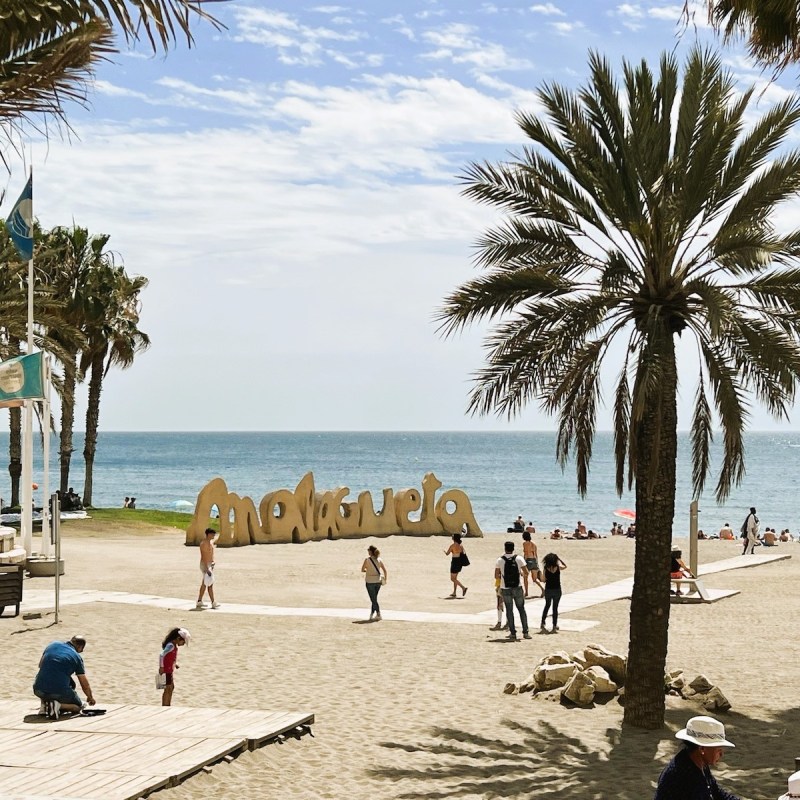
The grand cities of Europe are teeming with visitors and for many great reasons. But sometimes, you want the same outstanding amenities and attractions at a less, well, frenetic pace. That’s why I love Málaga on the Costa del Sol in the sunny south of Spain.
Videos by TravelAwaits
Compact and cosmopolitan, Málaga is embraced on one side by a thriving Mediterranean seaport shared by mega-yachts, ocean liners, excursion boats, and container barges. On the other is a low-rise mountain range. The city is rich in history, art, gardens, and cuisine. And it’s the hometown of both modern artist Pablo Picasso and movie actor Antonio Banderas.
I’ve been fortunate to travel through much of Europe, Spain, and the Costa del Sol as a personal traveler and once on a media trip. In my view, lesser-known and lesser-traveled Málaga is a hidden gem.
Let me tell you why (in no particular order):

1. The Parks And Gardens Of Málaga Are Bountiful
Málaga’s mild Mediterranean climate is a boon for all things botanical. You can’t miss the many towering palm trees and the jacarandas, which produce masses of royal purple blooms in the spring and fall.
Parque de Málaga, or simply Málaga Park, is a vast linear garden between the harbor and city center attractions. The first plantings were installed around 1900, making the park more than a century old. Today, the remarkable collection of trees, plants, and flowers includes tropical and subtropical species from around the world. Scattered throughout the park are smooth pathways, fountains and water features, statues and sculptures, a small outdoor theater, and children’s playgrounds.
Pro Tip: At the northwest corner of Málaga Park — at the intersection of Calle Molina Lario and Avenida Cervantes — there’s a City Sightseeing Hop-On Hop-Off bus stop. You can buy your tickets there, too.

2. Málaga Makes Ancient History
Málaga was settled by Phoenicians about 2,800 years ago, making it one of the oldest cities in Europe. In later centuries, it was conquered variously by Greeks, Romans, Moors, Catholics, and others, all of whom have left their signatures.
The most important heritage sites are La Alcazaba and Gibralfaro Castle, two walled Islamic fortresses on Gibralfaro Mountain. The hike up is a bit challenging, but the far-reaching views are worth it. (There’s an elevator to Alcazaba.)
Alcazaba, which originated in the 11th century, served as a royal residence and defense stronghold. As the older and more preserved of the two, the fortress is a labyrinth of living quarters, meeting rooms, gardens, and passageways. Some of the intricate tilework and mosaics remain for your viewing.
Higher up the mountainside is Gibralfaro Castle, built during the 14th century primarily as a defense settlement to protect Alcazaba. At the base of the mountain on Calle Alcazabilla is a well-excavated Roman amphitheater.

3. A World Of Art Is On Display In Málaga
From “Old Masters” paintings to funky street murals, Málaga is swathed in artistic expressions.
Overlooking the harbor is the Centre Pompidou Málaga, which you’ll easily recognize as a sort of Rubik’s Cube of colorful and transparent square panels. It’s the first outpost of the venerable institution of modern art, the Centre Pompidou in Paris. The exhibitions are housed on two underground levels. Within the center’s collections are works of 80 internationally lauded artists from the 20th and 21st centuries, including Marc Chagall, Frida Kahlo, and Rene Magritte.
The Carmen Thyssen Museum focuses on Spanish art and artists of the 19th century with a focus on Andalusian landscapes and lifestyle as well as special exhibitions.
Even Málaga’s street art incites wonderment. Midway along Calle Larios is a smooth bronze corkscrew-like sculpture. Stand back to observe how the outer edges reveal human facial profiles in each direction. It’s a work called Points of View by German artist Tony Cragg.

4. Málaga Celebrates Pablo Picasso
Native son Pablo Picasso, who was born in Málaga in 1881, commands two renowned museums. The first, located on Plaza de la Merced, is the Museo Casa Natal Picasso, also known as Picasso Birthplace Museum. Picasso was born in this building, and one exhibition is a recreated living and dining space furnished as it might have appeared when the family lived here. Other exhibitions feature his childhood drawings, significant motifs, and family mementos.
The second museum, Museo Picasso Málaga, is housed in a renovated 16th-century palace with an exquisite interior courtyard. The museum displays about 300 of the artist’s works, including paintings, drawings, ceramics, and sculptures. They are mostly arranged by chronology and style. It’s fascinating to realize the extensive range of his abilities, from realism to abstraction.
Pro Tip: In Merced Plaza, you can take a selfie with a bronze likeness of the artist sitting on a bench.

5. A Majestic Cathedral Stands In The City Center
After the long-standing Moors were cast out in 1487, Roman Catholic King Ferdinand II and Queen Isabella I ordered a cathedral to replace the city mosque. Construction began in 1528 and continued until the late 1700s when funding ran out. Only one of the two towers was ever completed. (Some say the money was sent to America to help fight the British during the Revolutionary War.)
Still, the Holy Cathedral Basilica of the Incarnation, or Málaga Cathedral, is a resplendent mix of Gothic, Renaissance, and Baroque architectural styles. A few of the many noteworthy interior features are the imposing vaulted ceilings more than 130 feet in height that are supported by fluted columns, intricately wood-carved choir stalls, 15 adorned chapels surrounding the perimeter, and dual organs with more than 4,500 pipes. That’s in addition to lavish embellishments of stained glass, statuary, paintings, and gilt.
Pro Tip: The cathedral is a central landmark. If you get lost — which I did on the many angled streets — you can go up to anyone and ask pathetically, “Cathedral?” You’ll be pointed in the right direction and can orient yourself accordingly.

6. Málaga Streets Are Easily Walkable
Calle Marqués de Larios, or simply Calle Larios, is an elegant pedestrian promenade and the most upscale shopping district in the city. It’s definitely the place to see and be seen. Built in 1891, the street is lined with lovely low-rise buildings detailed with rounded corners and frilly iron balcony railings.
Stroll along Calle Larios from Alameda Principal Street to Plaza de la Constitución (Constitution Plaza) and you’ll find chic boutiques, sidewalk entertainers, celebrants of all kinds, and works of art. Wander down any of the side streets for restaurants, bars, more shops, and more art.
Another fabulous walk is along the V-shaped harbor, the Puerto de Málaga. The semi-covered Muelle 2, or Pier 2, is lined with graceful palm gardens, shops, restaurants, and sidewalk entertainers. Open-air Muelle 1, or Pier 1, is the more convivial of the two, with boat docks, outdoor eateries, and stores. The brightly colored Pompidou museum stands at the crux of the V.
Want to get in even more steps? Follow Pier 1 to the stately La Farola Lighthouse, cross Paseo de la Farola Street, and you’ll come to another promenade that takes you past Playa de la Malagueta (Malagueta Beach). The elongated beach is dotted with restaurants, snack kiosks, chair and umbrella rentals, and a playground.
Pro Tips: The City Sightseeing boat docks at Pier 1. The City Sightseeing Hop-On Hop-Off bus stops at Malagueta Beach.

7. You’ll Take In The Sites By Bus And Boat
My favorite way to get an overview of the history and major sights of any city new to me is a tour on the City Sightseeing Hop-On Hop-Off bus.
The bright-red double-decker buses, now roaming more than 100 cities worldwide, circulate along prescribed routes with various stops for pick-up and drop-off along the way. You’re free to get off wherever you wish and catch another one later. Málaga tours are narrated in eight languages.
City Sightseeing also offers boating excursions in many cities, including Málaga, but most are not Hop-On and Hop-Off.
Pro Tip: Málaga has three Hop-On Hop-Off bus routes. The Red Line takes you past the city’s most iconic attractions, including beaches, parks, museums, ancient ruins, and La Farola Lighthouse.
Related Reading:

